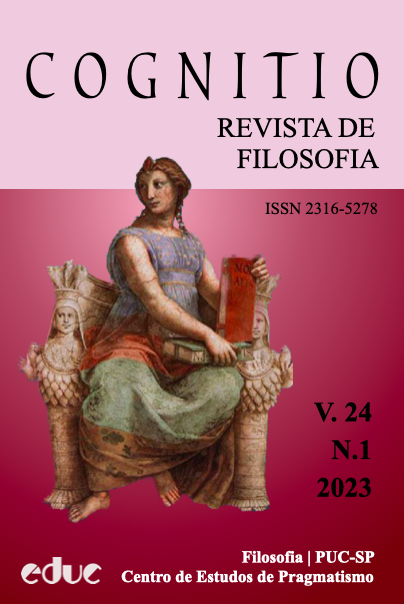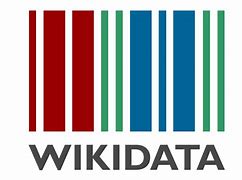Peirce’s three-dimensional notion of vagueness
some preliminary remarks
DOI:
https://doi.org/10.23925/2316-5278.2023v24i1:e61872Resumen
My aim in this paper is to provide some introductory coordinates aiming at orienting a unified discourse on the doctrine of vagueness in Peirce. After tracing some of the stages in Peircean scholarship that have brought the concept of vagueness into focus, I will show that vagueness, as it appears in Peircean philosophy, is a three-dimensional concept. Thus, while vagueness is a concept that appears in a logical-semiotic dimension – and more specifically as a problem related to the quantification of the subject within the propositional context – it is also articulated in an epistemological and metaphysical dimension. Here I focus primarily on the semiotic dimension and suggest how an account of vagueness might hold together the epistemological and metaphysical consequences of the notion of vagueness.
Citas
AGLER, D. Vagueness and its Boundaries: A Peircean Theory of Vagueness. M.A Thesis, Indianapolis: Indi- ana University-Purdue University, 2010.
AGLER, D. Peirce and the Specification of Borderline Vagueness. Semiotica, v. 193, p. 195-215, 2013. BELLUCCI, F. Exploring Peirce’s Speculative Grammar: The Immediate Object of a Sign. Sign Systems
Studies, v. 43, n. 4, p. 399-418, 2015.
BELLUCCI, F. Peirce’s Speculative Grammar: Logic as Semiotics. New York/London: Routledge, 2018.
BELLUCCI, F. (ed). Charles S. Peirce: Selected Writings on Semiotics 1894-1912. Berlin: Mouton De Gruy- ter, 2020.
BERGMAN, M. Fields of Significations: Explorations in Charles S. Peirce’s Theory of Signs. Philosophical Studies from the University of Helsinki 6, 2004.
BERGMAN, M. Peirce’s Philosophy of Communication: The Rhetorical Underpinning of the Theory of Signs, London and New York: Continuum Press, 2009.
BROCK, J. C. S. Peirce’s Logic of Vagueness. PhD, Philosophy, University of Illinois, Urbana, 1969. BROCK, J. An Introduction to Peirce’s Theory of Speech Acts. In Transactions of Charles S. Peirce Society,
v. 17, n. 4, p. 319-326, 1981a.
BROCK, J. The Origin and Structure of Peirce’s Logic of Vagueness. Zeichenkonstitution. Akten des 2 Semi-
otischen Kolloquiums Regensburg, p. 133-138, 1981b.
CHAUVIRÉ, C. Peirce et la signification: Introduction à la logique du vague. Paris: Presses Universitaires
de France, 1995.
CHAUVIRÉ, C. L’œil mathématique: essai sur la philosophie mathématique de Peirce. Paris: Éditions Kimé, 2008.
EGRÉ, P. Qu’est-ce que le vague?. Paris: Libraire Philosophique J. Vrin, 2018.
FABBRICHESI, R. Continuità e vaghezza: Leibniz, Goethe, Peirce, Wittgenstein. Milano: CUEM, 2001.
FABBRICHESI, R. Del certo e del vago. L’analisi del senso comune in Peirce e Wittgenstein. In: Semiotica ed ermeneutica, a cura di Carlo Sini, Quaderni di ACME, p. 9-44, 2003.
FISCH, M.; TURQUETTE, A. Peirce’s Triadic Logic. Transactions of the Charles S. Peirce Society, v. 2, n. 2, p. 71-85, 1966.
HILPINEN, R. On C. S. Peirce’s Theory of the Proposition: Peirce as a Precursor of Game-Theoretical Se- mantics. In: The Monist, v. 65, n. 2, p. 182-188, 1982.
JAMES, W. The Principles of Psychology. Cambridge and London: Harvard University Press, 1890-1891. LANE, R. Charles Sanders Peirce and The Principle of Bivalence. PhD, Philosophy, University of Miami,
LANE, R. Peirce’s Triadic Logic Revisited. Transactions of the Charles S. Peirce Society, v. 35, n. 2, p. 284- 311, 1999.
LANE, R. Peirce on Realism and Idealism. Cambridge: Cambridge University Press, 2018.
MADDALENA, G.; ZALAMEA, F. A New Analytic/Synthetic/Horotic Paradigm. From Mathematical Ges- ture to Synthetic/Horotic Reasoning. European Journal of Pragmatism and American Philosophy, v. 4, n. 2, 2012.
PEIRCE. C. S. The Charles S. Peirce Papers, 1787-1951, MS Am 1632. Houghton Library, Harvard Univer- sity, 1787-1951. (Ms).
PEIRCE, C. S. Collected Papers of Charles Sanders Peirce. 8 vols, edited by C. Hartshorne, P. Weiss, and A. Burks. Cambridge: Harvard University Press, 1932-1958. (CP).
PEIRCE, C. S. The Essential Peirce. Selected Philosophical Writings, v. 1: 1867-1893, ed. by Nathan Houser and Christian Kloesel; v. 2: 1893-1913, ed. by The Peirce Edition Project. Bloomington: Indiana University Press, 1992-1998. (EP1).
PEIRCE, C. S. Writings of Charles S. Peirce: A Chronological Edition, vols. 1-6, 8. 1982, v. 1: M. H. Fisch (ed.); 1984, v. 2: E. C. Moore (ed.); 1986, v. 3; 1989, v. 4; 1993, v. 5: C. J. W. Kloesel (ed.); 2000, v. 6; 2010, v. 8: Peirce Edition Project (ed.). Bloomington: Indiana University Press, 1982-2010. (W).
ROYCE, J. The Harrison Lectures: The Nature and Accessibility of Absolute Truth. Manuscripts transcribed by Joe Dillabough, 1911. https://josiah-royce-edition.org.
ROYCE, J. The World and the Individual. New York and London: The MacMillan Company. 2 vol., 1916. RUSSELL, B., Vagueness. Australasian Journal of Philosophy, v. 1, n. 2, p. 84-92, 1923.
THIBAUD, P. Between Saying and Doing: Peirce’s Propositional Space. Transactions of the Charles S. Peirce Society, v. 33, n. 2, p. 270-327, 1997.
TIERCELIN, C. Le vague est-il réel? Sur le réalisme de C. S. Peirce. Philosophie, v. 10, p. 69-96, 1986. TIERCELIN, C. Peirce ou le projet d’une logique du vague. Archives de Philosophie, v. 4, n. 1, p. 553-579,
TIERCELIN, C. Vagueness and the Unity of Peirce’s Realism. Transactions of the C. S. Peirce Society, v. 28, p. 51-82, 1992.
TIERCELIN, C. Pragmatism and Vagueness: The Venetian Lectures. G. Tuzet (ed.), Mimesis international, 2019.
TURQUETTE, A. Peirce’s Complete Systems of Triadic Logic. Transactions of the Charles S. Peirce Society, v. 5, n. 4, p. 199-210, 1969.
VIOLA, T. From Vague Symbols to Contested Concepts: Peirce, W. B. Gallie, and History. History and The- ory, v. 58, n. 2, p. 233-251, 2019.
WILLIAMSON, T. Vagueness. New York: Routledge, 1994.
Descargas
Publicado
Cómo citar
Número
Sección
Licencia
Derechos de autor 2023 http://creativecommons.org/licenses/by/4.0/

Esta obra está bajo una licencia internacional Creative Commons Atribución 4.0.









